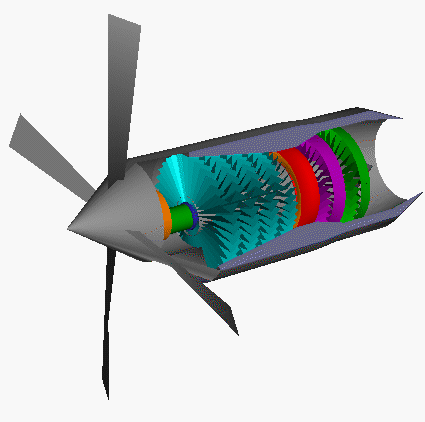
|
This page is intended for college, high school, or middle school students.
For younger students, a simpler explanation of the information on this page is
available on the
Kids Page.
|

|
Turboprop
Engine
|
Glenn
Research
Center
|








To move an
airplane
through the air,
thrust
is generated with some kind of
propulsion system.
Many low speed transport
aircraft and small commuter aircraft use turboprop propulsion.
On this page we will discuss some of the fundamentals of turboprop
engines. The turboprop uses a gas turbine
core
to turn a propeller. As mentioned on a previous page,
propeller engines
develop thrust by moving a large mass of air through a
small change in velocity. Propellers are very efficient and can use
nearly any kind of engine to turn the prop (including humans!). In
the turboprop, a gas turbine core is used. How does a turboprop
engine work?
There are two main
parts
to a
turboprop propulsion system, the core engine and the propeller. The
core is very similar to a
basic turbojet
except that instead of expanding all the hot exhaust through the
nozzle to produce thrust, most of the energy of the exhaust is used
to turn the turbine. There may be an additional turbine stage
present, as shown in green on the
diagram,
which is connected to a drive shaft. The drive shaft, also shown in
green, is connected to a gear box. The gear box is then
connected to a propeller that produces most of the thrust. The
exhaust velocity of a turboprop is low and contributes little thrust
because most of the energy of the core exhaust has gone into turning
the drive shaft.
Because propellers become less efficient as the speed of the
aircraft increases, turboprops are used only for low speed aircraft
like cargo planes. High speed transports usually use
high bypass turbofans
because of the high fuel efficiency and high
speed capability of turbofans. A variation of the turboprop engine is
the turboshaft engine. In a turboshaft engine, the gear box is
not connected to a propeller but to some other drive device.
Turboshaft engines are used in many helicopters, as well as tanks,
boats, and even race cars in the late 1960's.
The
thrust equation
for a turboprop is
given on a separate slide.
Activities:


Guided Tours
Navigation ..

- Beginner's Guide Home Page
|
